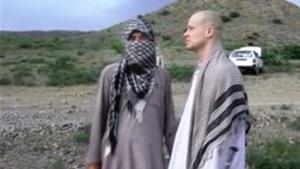TerrorismPentagon is capable of tracking the Taliban 5 freed from Guantanamo: experts
Critics of the White House’s release of five Taliban prisoners (Taliban 5) from Guantanamo Bay to Qatar are concerned that the group will eventually return to the battlefield in Afghanistan, posing a threat to American forces. Secretary of State John Kerry has said that doing so will open the terrorists to possible drone strikes; but that requires knowledge of their whereabouts. How might intelligence analysts track the Taliban 5 during and after their stay in Qatar? Experts say that the Pentagon is capable of tracking the former detainees using algorithms that predict terrorists’ movements based on their personal history and network.

Bowe Bergdahl waits for transfer // Source: voakorea.com
Critics of the White House’s release of five Taliban prisoners (Taliban 5) from Guantanamo Bay to Qatar are concerned that the group will eventually return to the battlefield in Afghanistan, posing a threat to American forces. The Daily Beast reported earlier this month that U.S. intelligence officials expect four of the five former prisoners to rejoin Taliban forces. Secretary of State John Kerry has said that doing so will open the terrorists to possible drone strikes; but that requires knowledge of their whereabouts.
How might intelligence analysts track the Taliban 5 during and after their stay in Qatar? Experts say that the Pentagon is capable of tracking the former detainees using algorithms that predict terrorists’ movements based on their personal history and network.
Former prisoners can be tracked with GPS if they have been implanted with trackers, but the United States has not disclosed whether it engages in the practice. Defense One reports that V. S. Subrahmanian, a computer science professor at the University of Maryland, suggests that his computer model, built to anticipate terrorist movements, is an option for tracking the Taliban 5. In the book Computational Analysis of Terrorist Groups: Lashkar-e-Taiba, Subrahmanian and fellow researchers used complex data analysis to predict the behavior of the Lashkar-e-Taiba and Indian Mujahideen terrorist groups. Their model has been credited with forecasting October 2013 attacks on the life of Indian prime ministerial Candidate Narendra Modi in Patna, India; as well as finding weapons caches in Iraq and Afghanistan.
“It works like a beacon,” Subrahmanian said. “When the condition is lit or not lit, you have a good understanding of whether or not the attack would occur in the next few months. You want to see if multiple of these conditions are turned on. If they are lit then you have great confidence of an attack.”
Subrahmanian added, “in our Lashkar-e-Taiba study, we looked at 770 variables about the group as a whole. Here, what I would do is look at variables associated with each individual. These would include family members, people they have carried out attacks within the past, organizations that they were associated with in the past like madrassas and charitable organizations. We would try to build a dataset to look at how these connections over the years have evolved, and links between those organizations are correlated with…So instead of just trying to predict how a network would evolve over time, you would be trying to predict who in the network these individuals would stay in touch with and then you would monitor those people extremely closely in addition to trying to monitor these individuals directly.”
Subrahmanian believes that the intelligence accumulated by U.S. officials throughout the years of the Taliban 5’s imprisonment in Guantanamo Bay is enough to build a model that can predict, with 80 percent accuracy, revealing who the Taliban 5 is likely to connect with in Qatar but also how those networks would change. “When they leave Qatar, they will have to rely on someone for logistical and financial support,” he said, assuming the group rejoins the battle against U.S forces. “The information gathered from all these people will allow U.S. military and intelligence sources to have a great picture of how these groups are connected to jihadists in Pakistan and Afghanistan.”
